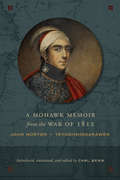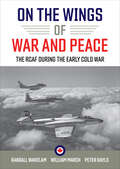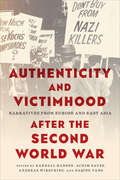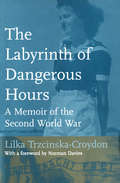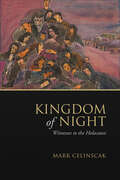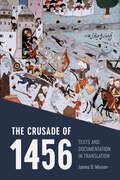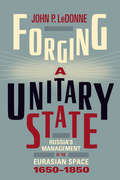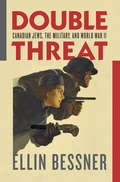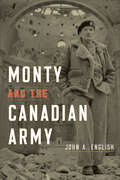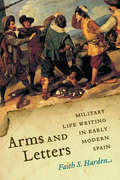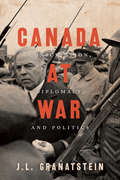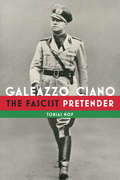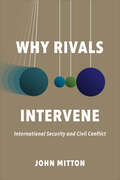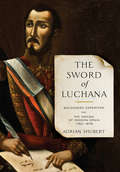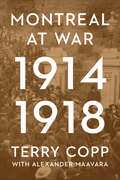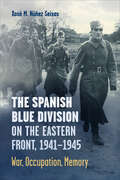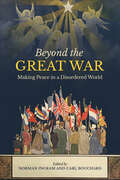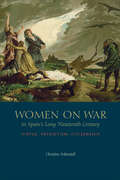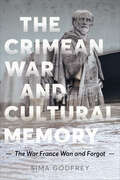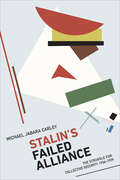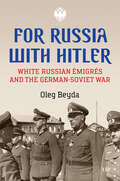- Table View
- List View
A Mohawk Memoir from the War of 1812: John Norton - Teyoninhokarawen
by John Norton TeyoninkarawenA Mohawk Memoir from the War of 1812 presents the story of John Norton, or Teyoninhokarawen, an important war chief and political figure among the Grand River Haudenosaunee (or Iroquois) in Upper Canada. Norton saw more action during the conflict than almost anyone else, being present at the fall of Detroit, the capture of Fort Niagara, the battles of Queenston Heights, Fort George, Stoney Creek, Chippawa, and Lundy’s Lane, the blockades of Fort George and Fort Erie, as well as a large number of skirmishes and front-line patrols. His memoir describes the fighting, the stresses suffered by indigenous peoples, and the complex relationships between the Haudenosaunee and both their British allies and other First Nations communities. Norton’s words, written in 1815 and 1816, provide nearly one-third of the book’s content, with the remainder consisting of Carl Benn’s introductions and annotations, which enable readers to understand Norton’s fascinating autobiography within its historical contexts. With the assistance of modern scholarship, A Mohawk Memoir presents an exceptional opportunity to explore the War of 1812 and native-newcomer issues through Teyoninhokarawen’s Mohawk perspectives from a period that produced few indigenous autobiographies, of which Norton’s is the most extensive, engaging, and reliable.
On the Wings of War and Peace: The RCAF during the Early Cold War
by William March Randall Wakelam Peter RaylsBringing together leading researchers on Canadian air power, On the Wings of War and Peace captures the history of the Royal Canadian Air Force (RCAF) during the first decades of the Cold War – a period which marked the zenith of air force accomplishments in peacetime Canada. The volume covers topics that go beyond straightforward flying operations, examining policies that drove operational needs and capabilities and the personnel, technical, and logistical functions that made those operations possible. With contributions written by former RCAF members who have both expert and personal knowledge of their topics, On the Wings of War and Peace brings new perspectives to the RCAF’s role in shaping the modern Canadian nation.
Authenticity and Victimhood after the Second World War: Narratives from Europe and East Asia (German and European Studies)
by Hansen, Randall, et al.The shadow of the Second World War was filled with many terrible crimes, crimes, such as genocide, forced migration and labour, human-made famine, forced sterilizations, and dispossession, that. None of these atrocities were new, but they all occurred on an unprecedented scale. Authenticity and Victimhood after the Second World War examines victim groups constructed in the twentieth century in the aftermath of these experiences. The collection explores the concept of authenticity through an examination of victims’ histories and the construction of victimhood in Europe and East Asia. Chapters consider how notions of historical authenticity influence the self-identification and public recognition of a given social group, the tensions arising from individual and group experiences of victimhood, and the resulting, sometimes divergent, interpretation of historical events. Drawing from case studies on topics including the Holocaust, the siege of Leningrad, American air raids on Japan, and forced migrations from Eastern Europe, Authenticity and Victimhood after the Second World War shows demonstrates the trends towards a victim-centred collective memory as well as the interand the role trends play of in memory politics and public commemorative culture.
The Labyrinth of Dangerous Hours: A Memoir of the Second World War
by Norman Davies Lilka Trzcinska-CroydonLilka Trzcinska was fourteen years old when the Nazis invaded Poland in 1939. The daughter of an architect, Lilka was a high school student at the time. When schools were closed by the occupier, she, along with her siblings, continued their education in secret classes, and joined the Polish Home Army (the secret resistance force). Lilka and her family were arrested by the Gestapo in 1943 and sent to the political prison Pawiak, then to Auschwitz. There, Lilka's mother died and her younger sister was sent off to another camp. The rest of the family was put to work in the camp building offices. After being transported to a number of different camps, the three sisters were reunited in 1945, and shortly thereafter liberated by the British. Lilka later went to Italy to continue her education, moving to Canada in 1948. The Labyrinth of Dangerous Hours is the memoir of a survivor. Lilka Trzcinska-Croydon narrates her adolescence and that of her sisters and brother in a way that binds poetry and history together seamlessly. It describes the strength of the family ties and solidarity that helped them emerge from their horrific ordeal with their dignity intact. As many as 150,000 Polish political prisoners were taken during the war, half of whom died in the camps. This memoir is a testament to their struggle.
Violence, Order, and Unrest: A History of British North America, 1749–1876
by Elizabeth Mancke Jerry Bannister Denis B. McKim Scott W. SeeThis edited collection offers a broad reinterpretation of the origins of Canada. Drawing on cutting-edge research in a number of fields, Violence, Order, and Unrest explores the development of British North America from the mid-eighteenth century through the aftermath of Confederation. The chapters cover an ambitious range of topics, from Indigenous culture to municipal politics, public executions to runaway slave advertisements. Cumulatively, this book examines the diversity of Indigenous and colonial experiences across northern North America and provides fresh perspectives on the crucial roles of violence and unrest in attempts to establish British authority in Indigenous territories. Drawing on specific case studies of law and state formation in English and French Canada, Violence, Order, and Unrest brings together innovative research in different fields to reconsider the ideology, governance, and political culture that underpinned British North America. The contributors offer a unique take on Canadian culture and history, demonstrating that we cannot understand Canada today without considering its origins as a colonial project.
Spain, the Second World War, and the Holocaust: History and Representation (Toronto Iberic)
by Gina Herrmann Sara J. BrenneisSpain has for too long been considered peripheral to the human catastrophes of World War II and the Holocaust. This volume is the first broadly interdisciplinary, scholarly collection to situate Spain in a position of influence in the history and culture of the Second World War. Featuring essays by international experts in the fields of history, literary studies, cultural studies, political science, sociology, and film studies, this book clarifies historical issues within Spain while also demonstrating the impact of Spain's involvement in the Second World War on historical memory of the Holocaust. Many of the contributors have done extensive archival research, bringing new information and perspectives to the table, and in many cases the essays published here analyze primary and secondary material previously unavailable in English. Spain, the Second World War, and the Holocaust reaches beyond discipline, genre, nation, and time period to offer previously unknown evidence of Spain’s continued relevance to the Holocaust and the Second World War.
Kingdom of Night: Witnesses to the Holocaust
by Mark CelinscakIn April 1945, when the Bergen-Belsen concentration camp was surrendered and handed over to the British Army, Canadian forces arrived on scene to provide support, to bear witness, and to document the crimes. They were overwhelmed, understaffed, and left without adequate supplies, equipment, and medicine. Their encounters at the camp were haunting, transformative experiences that forever changed their lives. In Kingdom of Night, Mark Celinscak reveals the engagement of Canadian troops and other personnel at the Bergen-Belsen concentration camp. The book brings together a series of gripping, often deeply moving accounts that demonstrate the critical relief work carried out by Canadians who have been largely overlooked for more than seventy-five years. It outlines in both stark and moving detail what a cross-section of Canadians both said and did during the liberation efforts at one of the most notorious sites in Hitler’s camp system. In addition, biographical overviews are presented for each Canadian featured in the book, not only highlighting some of their life-saving and humanitarian work, but also revealing what ultimately became of their lives after the war. Kingdom of Night depicts the gruelling efforts by those who assisted the victims of one of the greatest crimes in history.
The Crusade of 1456: Texts and Documentation in Translation
by James D. MixsonIn July 1456, a massive Turkish army settled in before Belgrade, an ancient city at the confluence of the Danube and Sava rivers. The army’s leader was the twenty-four-year-old Ottoman sultan Mehmed II, "the Conqueror," who sought to take one of the most strategically important fortifications in southeastern Europe. Three weeks later, Mehmed’s army was driven from Belgrade by a Hungarian warlord and his army, along with a ragtag force of ill-equipped crusaders. In The Crusade of 1456, James D. Mixson gathers together the key primary sources for understanding the events that led to the siege of Belgrade. These newly translated sources challenge readers with their variety: papal decrees, letters, liturgies, and chronicles from Latin, Byzantine, and Ottoman perspectives. An accessible introduction, timelines, and maps help to illuminate this fascinating yet previously neglected story.
The United Nations Genocide Convention: An Introduction (G - Reference, Information And Interdisciplinary Subjects Ser.)
by Samuel Totten Henry C. TheriaultIt is virtually impossible to understand the phenomenon of genocide without a clear understanding of the complexities of the United Nations Convention on the Prevention and Punishment of the Crime of Genocide (UNCG). This brief but cogent book provides an introduction to the unique wording, legal terminology, and key components of the convention, which was adopted by the United Nations General Assembly in 1948. Providing clarity on the distinctions between genocide, crimes against humanity, war crimes, and ethnic cleansing, this book is designed to be an entry into further study of genocide in its legal, historical, political, and philosophical dimensions. Key terms, such as intent and motive, are explained, case studies are included, and a detailed bibliography at the conclusion of the book offers suggested avenues for more advanced study of the UNCG.
Forging a Unitary State: Russia’s Management of the Eurasian Space, 1650–1850
by John P. LeDonneCovering two centuries of Russian history, Forging a Unitary State is a comprehensive account of the creation of what is commonly known as the "Russian Empire," from Poland to Siberia. In this book, John P. LeDonne demonstrates that the so-called empire was, for the most part, a unitary state, defined by an obsessive emphasis on centralization and uniformity. The standardization of local administration, the judicial system, tax regime, and commercial policy were carried out slowly but systematically over eight generations, in the hope of integrating people on the periphery into the Russian political and social hierarchy. The ultimate goal of Russian policy was to create a "Fortress Empire" consisting of a huge Russian unitary state flanked by a few peripheral territories, such as Finland, Transcaucasia, and Central Asia. Additional peripheral states, such as Sweden, Turkey, and Persia, would guarantee the security of this "Fortress Empire," and the management of Eurasian territory. LeDonne’s provocative argument is supported by a careful comparative study of Russian expansion along its western, southern, and eastern borders, drawing on vital but under-studied administrative evidence. Forging a Unitary State is an essential resource for those interested in the long history of Russian expansionism.
Double Threat: Canadian Jews, the Military, and World War II
by Ellin Bessner"He died so Jewry should suffer no more." These words on a Canadian Jewish soldier's tombstone in Normandy inspired the author to explore the role of Canadian Jews in the war effort. As PM Mackenzie King wrote in 1947, Jewish servicemen faced a "double threat" - they were not only fighting against Fascism but for Jewish survival. At the same time, they encountered widespread antisemitism and the danger of being identified as Jews if captured. Bessner conducted hundreds of interviews and extensive archival research to paint a complex picture of the 17,000 Canadian Jews - about 10 per cent of the Jewish population in wartime Canada - who chose to enlist, including future Cabinet minister Barney Danson, future game-show host Monty Hall, and comedians Wayne and Shuster. Added to this fascinating account are Jews who were among the so-called "Zombies" - Canadians who were drafted, but chose to serve at home - the various perspectives of the Jewish community, and the participation of Canadian Jewish women.
Monty and the Canadian Army
by John A. EnglishGeneral Bernard Law Montgomery, affectionately known as "Monty," exerted an influence on the Canadian Army more lasting than that of any other Second World War commander. In 1942 he assumed responsibility for the exercise and training of Canadian formations in England, and by the end of the war Canada’s field army was second to none in the practical exercise of combined arms. In Monty and the Canadian Army, John A. English analyses the way Montgomery’s operational influence continued to permeate the Canadian Army. For years, the Canadian Army remained a highly professional force largely because it was commanded at almost every lower level by "Monty men" steeped in the Montgomery method. The era of the Canadian Army headed by such men ceased with the integration and unification of Canada’s armed forces in 1964. The embrace of Montgomery by Canadian soldiers stands in marked contrast to largely negative perceptions held by Americans. Monty and the Canadian Army aims to correct such perceptions, which are mostly superficial and more often than not wrong, and addresses the anomaly of how this gifted general, one of the greatest field commanders of the Second World War, managed to win over other North American troops.
Arms and Letters: Military Life Writing in Early Modern Spain (Toronto Iberic)
by Faith S. HardenArms and Letters analyses the unprecedented number of autobiographical accounts written by Spanish soldiers during the sixteenth and seventeenth centuries. These first-person retrospective works recount a range of experiences throughout the sprawling domain of the Hispanic monarchy. Reading a selection of autobiographies in contemporary historical context – including the coalescing of the first modern armies, which were partially populated by forced recruits and the urban poor – Faith S. Harden explains how soldiers adapted the concept of honour and contributed to the burgeoning autobiographical form. Harden argues that Spanish military life writing took two broad forms: the first as a petition, wherein the soldier’s service was presented as a debt of honour, and second, as a series of misadventures, staging honour as a spectacle that captivated an audience. Honour was inevitably gendered and performative, and as such, it functioned as one of the overarching metrics of value that early modern men and women applied to themselves and others. In charting how non-elite subjects rendered their lives legitimate through autobiography, Arms and Letters contributes both to a critical genealogy of honour and to the history of life writing.
Canada at War: Conscription, Diplomacy, and Politics (G - Reference,information And Interdisciplinary Subjects Ser.)
by J.L. GranatsteinWar can subject nations and their peoples to immense strain, and the dangers both tear societies apart and transform attitudes at a great pace. In this collection of his previously published essays on the two world wars, J.L. Granatstein brings together research from archives in Canada and abroad, illuminating Canada’s political transition from the British to American sphere of influence in the first half of the twentieth century. Canada at War examines the impact of both world wars on Canada and Canadians by examining conscription, foreign policy, and politics, with William Lyon Mackenzie King, Canada’s longest-serving prime minister, acting as the book’s central figure. Mackenzie King knew that Canada had barely survived the conscription crisis of the Great War, and he strove to avoid similar political strains in the Second World War. In Canada at War, Granatstein reflects on the most significant issues affecting Canadians during the wars, showing how this period ushered change into the Canadian landscape and transformed Canada into the country that it is today.
Galeazzo Ciano: The Fascist Pretender (Toronto Italian Studies)
by Tobias HofBuilding on extensive archival research and important scholarly analysis, Galeazzo Ciano: The Fascist Pretender examines the life of Galeazzo Ciano, foreign minister of fascist Italy from 1936 to 1943 and Benito Mussolini’s son-in-law. Ciano’s life serves as a lens through which to gain a better understanding of crucial issues of Italian and European fascism, including the fascistization of society and politics, foreign relations, and the problem of succession. The biography follows an innovative thematic structure that focuses on major aspects of Ciano’s life, including his family, his political career, his diplomacy, and his desire to succeed Mussolini. Filling a substantial gap in the existing literature on the history of fascism, this book is the first comprehensive analysis of a key player of Italian fascism other than Mussolini; it also offers a long overdue critical assessment of Ciano’s famous diary, one of the most important texts from the period. Using visual materials such as photographs and films as sources and not just as illustrative material, Tobias Hof allows us to rethink our understanding of fascism and offers a new perspective on the history of fascist Italy.
Why Rivals Intervene: International Security and Civil Conflict
by John MittonRivals – states with acrimonious, militarized histories – often intervene on opposing sides of civil conflicts. These interventions are known to exacerbate and prolong civil wars, but scholars have yet to fully understand why states engage in them, given the significant costs and countervailing strategic interests. Why Rivals Intervene argues that rivals are driven by security considerations at the international level – specifically, the prospect of future confrontations with their rival – to intervene in civil conflicts. Drawing on a theory of rivalry which accounts for this strategic rationale, John Mitton explores three case studies: Indian and Pakistani intervention in Afghanistan, Israeli and Syrian intervention in Lebanon, and US and Soviet intervention in Angola. The book examines a range of evidence, including declassified memoranda, meeting transcripts, government reports, published interviews, memoirs of political leaders, and other evidence of the thought process, rationale, and justifications of relevant decision-makers. The book claims that the imperatives for intervention are consistent across time and space, as rivals are conditioned by a history of conflict to worry about future confrontations. As a result, Why Rivals Intervene illuminates an important driver of civil conflict, with implications for how such conflicts might be solved or mitigated in the future. At the same time, it offers new insight into the nature of long-standing, acrimonious international relationships.
The Sword of Luchana: Baldomero Espartero and the Making of Modern Spain, 1793–1879 (Toronto Iberic)
by Adrian ShubertBorn into obscurity in a rural backwater of central Spain in the waning years of the eighteenth century, Baldomero Espartero (1793–1879) led a life resembling that of a character created by Stendhal or Gabriel García Márquez. As a seventy-five-year-old man he was offered – and turned down – the throne of an industrializing nation. During his illustrious life, he fought against Napoleon, Simón Bolívar, and other Latin American independence leaders; won a seven-year civil war; served as regent for the child queen Isabella II; and spent years in exile in England. He governed as prime minister and also received multiple noble titles, including that of prince, which was normally reserved for members of the royal family. By his sixties, Espartero represented an almost mythical figure. Based on comprehensive archival research in Spain, Argentina, and the United Kingdom, The Sword of Luchana explores the public and private lives of this archetypal nineteenth-century hero. Adrian Shubert gives voice to the mass of ordinary Spaniards who revered Espartero as the embodiment of liberty and freedom, and to Jacinta Martínez de Sicilia y Santa Cruz, his wife of more than fifty years who played a key role in his public career. Including unprecedented access to Espartero’s personal papers, and set against the background of wars and revolutions in Spain and its American empire, The Sword of Luchana is a compelling account of the history of a crucial period of war, revolution, and political and social change.
Montreal at War, 1914–1918 (The Canadian Experience of War)
by Terry CoppDrawing from newspapers, journals, government reports, and archival records, Terry Copp – one of Canada’s leading military historians – tells the story of how citizens in Canada’s largest city responded to the challenges of the First World War. Montreal at War addresses responses to the outbreak of war in Europe and the process of raising an army for service overseas. It details the shock of intense combat and heavy casualties, studies the mobilization of volunteers, and follows the experience of battalions from Montreal to the Battle of Vimy Ridge. Challenging long-held assumptions, Montreal at War aims to understand the war experience as it unfolded, approaching history from the perspective of those who lived through it.
The Spanish Blue Division on the Eastern Front, 1941–1945: War, Occupation, Memory (Toronto Iberic)
by Xosé Núñez SeixasIn 1941, the Franco regime established the Spanish Division of Volunteers to take part in the Russian campaign as a unit integrated into the German Wehrmacht. Recruited by both the Fascist Party (Falange) and the Spanish army, around 47,000 Spanish volunteers joined what would become known as the "Blue Division." The Spanish Blue Division on the Eastern Front, 1941–1945 explores an intimate history of the Blue Division "from below," using personal war diaries, letters, and memoirs, as well as official documents from military archives in Spain, Germany, Britain, and Russia. In addition to describing the Spanish experience on the Eastern Front, Xosé M. Núñez Seixas takes on controversial topics including the Blue Division’s proximity to the Holocaust and how members of the Blue Division have been remembered and commemorated. Addressing issues such as the behaviour of the Spaniards as occupiers, their perception by the Russians, their witnessing of the Holocaust, their commitment to the war aims of Nazi Germany, and their narratives on the war after 1945, this book illuminates the experience of Spanish combatants and occupied civilians.
Beyond the Great War: Making Peace in a Disordered World
by Norman Ingram Carl BouchardFollowing the end of the First World War, a new world order emerged from the Paris Peace Conference of 1919. It was an order riddled with contradictions and problems that were only finally resolved after the Second World War. Beyond the Great War brings together a group of both well-established and younger historians who share a rejection of the dominant view of the peace process that ended the First World War. The book expands beyond the traditional focus on diplomatic and high political history to question the assumption that the Paris Peace Treaties were the progenitors of a new world order. Extending the ongoing debate about the success of the Treaty of Versailles and surrounding events, this collection approaches the heritage of the Great War through a variety of lenses: gender, race, the high politics of diplomacy, the peace movement, provision for veterans, international science, socialism, and the way the war ended. Collectively, contributors argue that the treaties were at best a mitigated success, and that the "brave new world" of 1919 cannot be separated from the Great War that preceded it.
Women on War in Spain’s Long Nineteenth Century: Virtue, Patriotism, Citizenship (Toronto Iberic)
by Christine ArkinstallThe ways in which women have historically authorized themselves to write on war has blurred conventionally gendered lines, intertwining the personal with the political. Women on War in Spain’s Long Nineteenth Century explores, through feminist lenses, the cultural representations of late nineteenth- and early twentieth-century Spanish women’s texts on war. Reshaping the current knowledge and understanding of key female authors in Spain’s fin de siècle, this book examines works by notable writers – including Rosario de Acuña, Blanca de los Rios, Concepción Arenal, and Carmen de Burgos – as they engage with the War of Independence, the Third Carlist War, Spain’s colonial wars, and World War I. The selected works foreground how women’s representations of war can challenge masculine conceptualizations of public and domestic spheres. Christine Arkinstall analyses the works’ overarching themes and symbols, such as honour, blood, the Virgin and the Mother, and the intersecting sexual, social, and racial contracts. In doing so, Arkinstall highlights how these texts imagine outcomes that deviate from established norms of femininity, offer new models to Spanish women, and interrogate the militaristic foundations of patriarchal societies.
Pathway to the Stars: 100 Years of the Royal Canadian Air Force
by Tom Jenkins Michael HoodPathway to the Stars takes readers on a remarkable journey spanning one hundred years of the Royal Canadian Air Force. This beautifully illustrated book shares the rich history of the Royal Canadian Air Force (RCAF) on its 100th anniversary. Produced in partnership with the RCAF Foundation, Pathway to the Stars tells the story of the people, the technologies, and the events that shaped the RCAF from 1924 to 2024. Presenting 100 stories to align with 100 years of the RCAF, the book explores the many ways in which the RCAF contributed to advances in aviation over the past century, from the invention of the G-suit to the development of the first helicopter landing system on a naval ship to the design of the first flight-safety organization for investigating crashes. As we look forward to the next generation of the RCAF, Pathway to the Stars brings to light an inspirational story about Canada and its place in the world over the past century. Proceeds from this book support the ongoing programs of the RCAF Foundation, a Canadian charity that works to celebrate Canada's rich aviation history and future.
The Crimean War and Cultural Memory: The War France Won and Forgot
by Sima GodfreyThe Crimean War (1854–56) is widely considered the first modern war with its tactical use of railways, telegraphs, and battleships, its long-range rifles, and its notorious trenches – precursors of the Great War. It is also the first media war: the first to know the impact of a correspondent on the field of battle and the first to be documented in photographs. No one, however, including the French themselves, seems to remember that France was there, fighting in Crimea, losing 95,000 soldiers and leading the Allied campaign to victory. It would seem that the Crimean War has no place in the canon of culturally retained historical events that define modern French identity. Looking at literature, art, theatre, material objects, and medical reports, The Crimean War and Cultural Memory considers how the Crimean War was and was not represented in French cultural history in the second half of the nineteenth century. Ultimately, the book illuminates the forgotten traces that the Crimean War left on the French cultural landscape.
Stalin’s Failed Alliance: The Struggle for Collective Security, 1936–1939
by Michael Jabara CarleyIn the spring of 1936, the Soviet effort to build an anti-Nazi alliance was failing. Stalin continued nevertheless to support diplomatic efforts to stop Nazi aggression in Europe. In Stalin’s Failed Alliance, the sequel to Stalin’s Gamble, Michael Jabara Carley continues his re-evaluation of European diplomacy during the critical events between May 1936 and August 1939. This narrative history examines the great crises of the pre-war period – the Spanish Civil War, Anschluss, and Munich accords – as well as both the last Soviet efforts to organize an anti-Nazi alliance in the spring–summer of 1939 and Moscow’s shocking volte-face, the signing of the Nazi-Soviet non-aggression pact. Carley’s history traces the lead-up to the outbreak of war in Europe on 1 September 1939 and sheds light on the Soviet Union’s efforts to organize a defensive alliance against Nazi Germany, in effect rebuilding the anti-German Entente of the First World War. The author argues for the sincerity of Soviet overtures to the western European powers and that the non-aggression pact was a last-ditch response to the refusal of other states, especially Britain and France, to conclude an alliance with the USSR against Nazi Germany. Drawing on extensive archival research in Soviet and Western archival papers, Stalin’s Failed Alliance aims to see the European crisis of the 1930s through Soviet eyes.
For Russia with Hitler: White Russian Émigrés and the German-Soviet War
by Oleg BeydaThe Bolshevik takeover of Russia created an alternative Russia in exile that never laid down its arms. For two decades, expelled White Russians sought ways to retaliate against the Soviet Union and return home. Their irreconcilability was galvanized by a superstructure, the dominant military organization, the Russian All-Military Union (ROVS). Eventually, militant anti-Bolshevism led the exiled Russians into alliance with Nazi Germany, despite the latter’s anti-Slavic stance. For Russia with Hitler tells the story of how thousands of White Russian émigrés joined the German invasion of the Soviet Union as soldiers, translators, and civilian workers. Oleg Beyda investigates and contextualizes émigré collaboration with National Socialist Germany, explaining how it was possible for Russians to fight against the Russians. The book reveals that the exiles, although united ideologically by Russian nationalism in a general sense, did not establish one single, clear-cut political solution for a future “liberated Russia.” Drawing on wide archival material, For Russia with Hitler details the background and ideological framework of the émigrés, how they rationalized their support for Nazism, and what they did on the Eastern Front, including their reactions to life in occupation, war crimes, and the Holocaust.
